Your dog’s aggressive face licking can stem from various reasons, including dominance assertion, stress, anxiety, or attention-seeking behavior.
It might also be rooted in instinctual pack behavior or indicate underlying health issues.
To manage this, establish clear boundaries and consistently redirect your dog’s attention when licking occurs.
Use positive reinforcement techniques and provide alternative activities to discourage excessive licking.
Regular exercise and mental stimulation can help reduce anxiety-related behaviors.
If the aggressive licking persists or is accompanied by other concerning signs, consult a veterinarian or dog behaviorist.
Understanding your dog’s unique motivations will help you address this behavior effectively.
Understanding Aggressive Face Licking
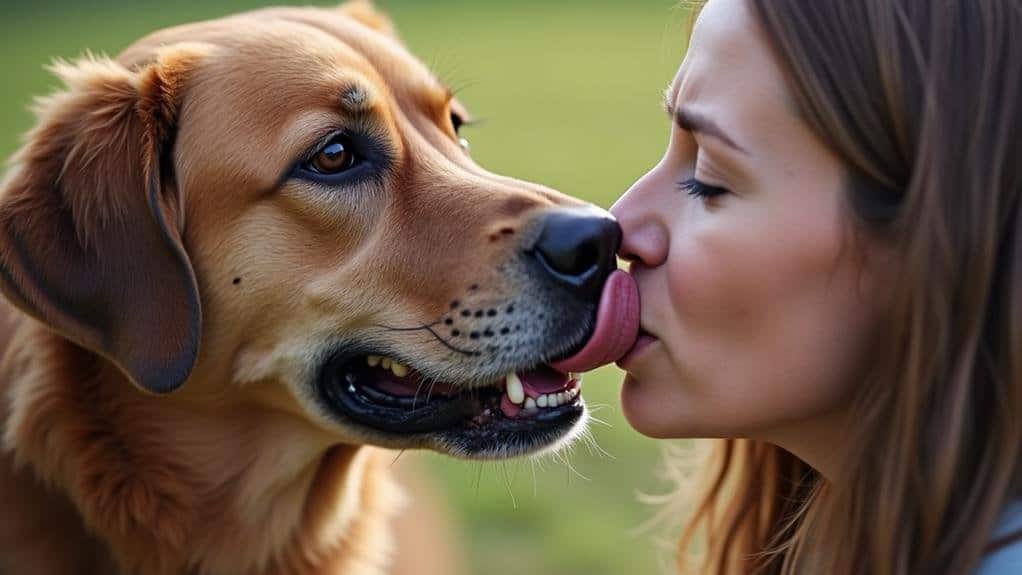
Five key aspects define aggressive face licking in dogs.
First, it’s often a display of dominance, characterized by direct eye contact and uninvited licking that asserts control over you or other dogs.
Second, it can signal frustration or anxiety, especially if your dog feels threatened or can’t reach something they want. In these cases, they may increase their licking as a coping mechanism.
Third, understanding your dog’s body language is essential. Aggressive licking can be a precursor to more serious behaviors like biting if you misinterpret or ignore it.
Fourth, dog licking serves as a form of social communication, helping dogs establish relationships and reinforce bonds. However, excessive aggression might indicate underlying behavioral issues.
Lastly, managing aggressive licking requires consistent training and clear boundaries. You’ll need to redirect the behavior through distractions or positive reinforcement techniques.
By recognizing these aspects, you can better interpret your dog’s intentions and address any stress or anxiety causing the behavior.
Instinctual Roots of Licking Behavior
Delving into the instinctual roots of dog licking behavior reveals a fascinating evolutionary journey. Your dog’s tendency to lick your face isn’t just a random act; it’s deeply rooted in their ancestral past. Wild dog cubs would lick their mothers’ faces to stimulate food regurgitation, a behavior that domestic puppies still mimic to signal hunger and elicit feeding.
When your dog licks you, they’re tapping into this primal instinct, using it as a form of non-threatening communication. It’s their way of reinforcing social bonds and expressing affection. Your positive reactions to this behavior, especially when they were puppies, have likely reinforced it as a learned expression of love and attention-seeking.
But there’s more to why dogs lick faces. Their superior sense of smell drives them to explore their environment through licking. When they lick your face, they’re picking up on residual scents and tastes that you mightn’t even be aware of.
Dominance and Submission Signals
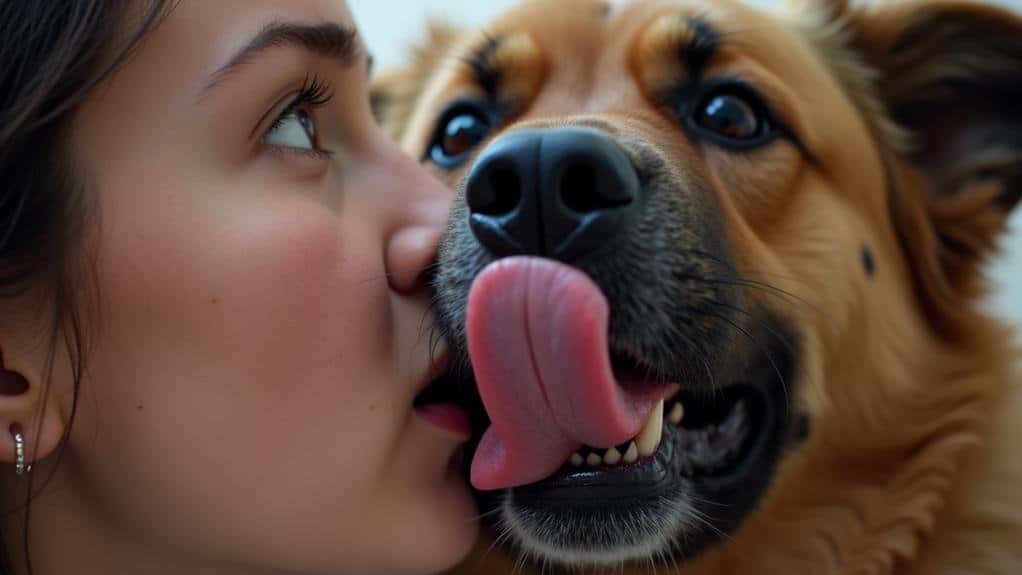
While many dog owners view face licking as purely affectionate, it’s important to recognize that this behavior can also convey dominance or submission signals. Aggressive licking, in particular, can be a display of dominance, where your dog attempts to assert control over you or other dogs. If your dog maintains intense eye contact during this behavior, it may be challenging you or showing disrespect, signaling a desire to establish hierarchy.
Pay close attention to your dog’s body language when they engage in uninvited licking behaviors, such as licking another dog’s ears. These actions can serve as dominance signals within canine social interactions.
It’s significant to understand that aggressive licking may escalate to more severe aggressive behaviors if misinterpreted or left unchecked.
To effectively manage and correct dominance-related licking behaviors, consistent training and establishing clear boundaries are fundamental. By recognizing the difference between affectionate licking and dominance displays, you’ll be better equipped to address the behavior appropriately.
Stress and Anxiety Indicators

Although many pet owners associate face licking with affection, it’s crucial to recognize that this behavior can also indicate stress or anxiety in dogs. Aggressive licking can be a coping mechanism for your furry friend when they’re feeling threatened or overwhelmed.
If you notice your dog excessively licking your face, it might be a sign that they’re experiencing heightened stress levels.
Separation anxiety is another common cause of aggressive licking. When you’re away, your dog may develop compulsive behaviors like face licking as a way to self-soothe. This behavior is similar to how humans might bite their nails when feeling anxious.
To help alleviate these underlying stressors, make sure your dog gets plenty of exercise and mental stimulation. Regular walks, playtime, and puzzle toys can greatly reduce anxiety-related behaviors.
If your dog’s aggressive licking persists despite your efforts, it’s time to consult a professional. A veterinarian can rule out any health issues, while a dog behaviorist can help identify and address specific anxiety triggers.
Attention-Seeking Through Licking
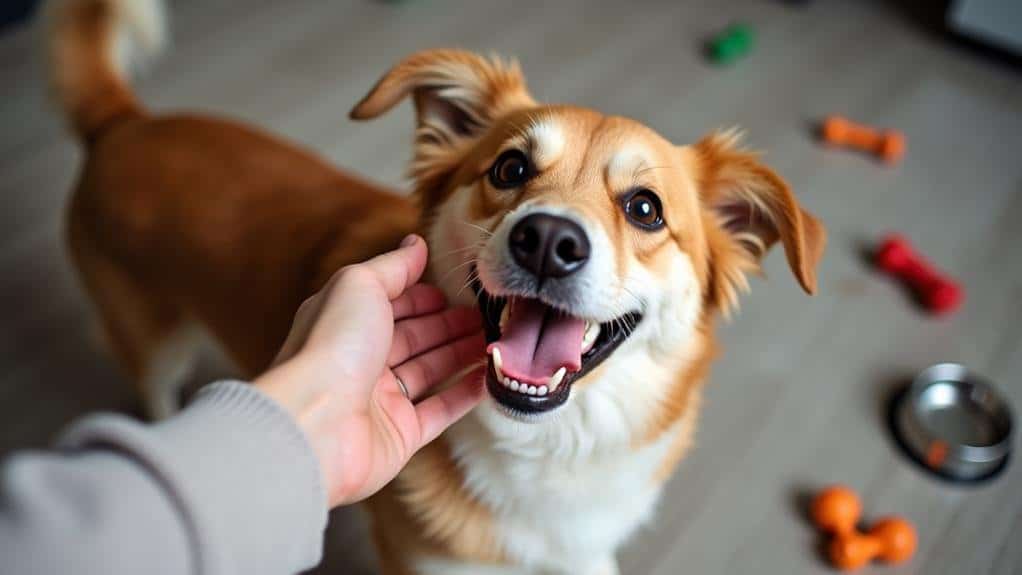
Enthusiastic for attention, dogs often resort to face licking as a surefire way to get their owners’ focus. This behavior can be reinforced regardless of your response, whether positive or negative.
Your dog may lick to communicate a desire for play or interaction, especially after waking up or during exciting moments.
To understand your dog’s intent, pay attention to the context of their licking, including body language and environmental cues. Excessive licking might indicate that your furry friend feels neglected or bored, using this behavior to remind you of their presence and needs.
If you want your dog to stop licking excessively, it’s essential to establish consistent boundaries. This approach will help promote more desirable interactions between you and your pet.
Remember that dogs are social creatures, and their licking behavior is often a way to connect with you.
Health Issues Behind Excessive Licking
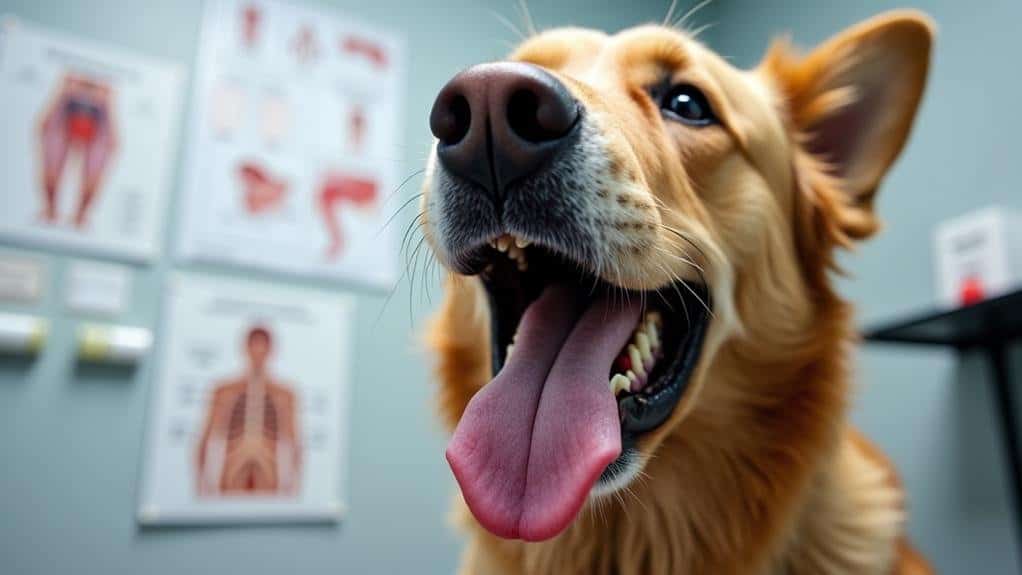
Three significant health issues can lurk behind your dog’s excessive face-licking behavior. While it’s easy to dismiss this as a harmless quirk, excessively licking could be a sign of underlying health problems that require veterinary attention.
Consider these potential health issues:
- Allergies and skin irritations
- Oral health problems
- Joint pain or arthritis
- Infections or hot spots
If your dog is excessively licking your face or other surfaces, it might be trying to alleviate discomfort from allergies or skin irritations.
Oral health issues, such as dental disease or gum problems, can also trigger this behavior. In some cases, dogs with arthritis or joint pain may lick as a way to soothe their discomfort.
It’s essential to address these health issues promptly, as chronic licking can lead to further complications like skin damage or infections.
Regular check-ups with your veterinarian can help identify and manage these problems early on.
If you notice your dog excessively licking, don’t hesitate to seek professional advice. Your vet can determine if there’s an underlying health issue causing this behavior and recommend appropriate treatment.
Training Techniques to Manage Licking

Managing your dog’s licking behavior requires consistent training and positive reinforcement. To curb aggressively licking, establish clear boundaries by redirecting your dog’s attention when they start to lick excessively. Introduce toys or activities as alternatives, keeping their mind occupied and reducing unwanted behavior.
Implement the “leave it” command during licking incidents to reinforce your training efforts. Reward calm behavior with treats or praise, encouraging your dog to refrain from licking. This positive reinforcement approach helps create a lasting association between good behavior and rewards.
Regular exercise and mental stimulation are essential in managing licking. Engage your dog in activities that burn excess energy and keep them mentally stimulated, reducing the likelihood of overstimulation that can lead to aggressive licking.
Consider using the Pacifier Technique by offering a chew toy or distraction tool. This keeps your dog’s mouth occupied and minimizes excessive licking behavior.
Redirecting Unwanted Licking Behavior
Successful redirection of unwanted licking behavior hinges on providing your dog with engaging alternatives. When you notice your dog starting to lick excessively, quickly offer a chew toy or initiate an interactive game. This shift in focus can effectively stop dog licks and channel their energy into more appropriate activities.
Consistent training commands play an essential role in redirecting unwanted licking behavior. Teach your dog the “leave it” command and use it consistently when licking occurs. Pair this with positive reinforcement techniques, rewarding your dog with treats or praise when they choose not to lick.
To further manage excessive licking, consider these strategies:
- Create a calm environment by minimizing overstimulation.
- Establish structured routines to reduce anxiety.
- Provide regular exercise to release pent-up energy.
- Offer mental stimulation through puzzle toys or training sessions.
When to Consult a Professional
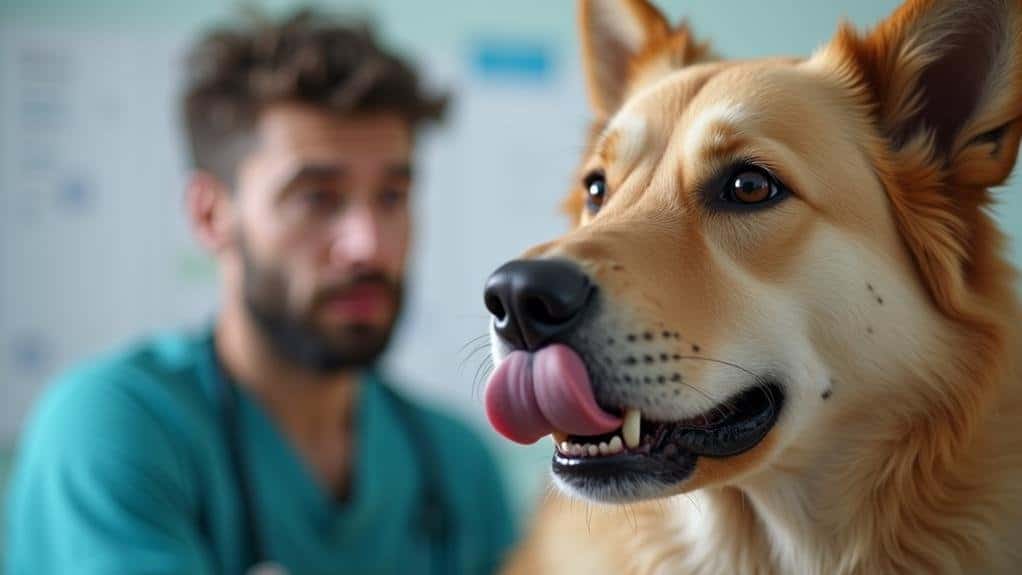
While many dog owners can successfully manage their pet’s licking behavior through training and redirection, there are instances when professional help becomes necessary.
If your dog’s aggressive licking persists despite your best efforts at managing it through training, it’s time to contemplate consulting a dog behavior consultant. These experts can provide professional guidance tailored to your specific situation.
Sudden changes in your dog’s licking behavior, especially if it becomes more aggressive, might signal underlying health issues.
In such cases, visit your veterinarian for a thorough examination. A professional can help identify triggers for aggressive licking that you mightn’t easily recognize, such as stress or dominance issues.
If your dog’s aggressive licking is accompanied by other concerning behaviors like growling or snapping, seek a detailed assessment from a behaviorist to guarantee everyone’s safety.
Remember, early intervention is key. By seeking help promptly, you can prevent the escalation of licking into more serious behavioral problems.
This proactive approach will promote a healthier relationship between you and your furry friend, guaranteeing a harmonious household for both of you.
Frequently Asked Questions
Why Does My Dog Lick My Face so Intensely?
Your dog’s intense face licking could be a sign of dominance, affection, or anxiety. It’s their way of communicating with you. Pay attention to their body language and context to understand the underlying reason for this behavior.
Is a Dog Licking Your Face Disrespectful?
Yes, aggressive face licking can be disrespectful. It’s often a sign of dominance, not affection. You should be cautious, as it may indicate boundary issues. If it’s uninvited or forceful, it’s best to address this behavior promptly.
How Do I Get My Dog to Stop Licking Faces?
To stop your dog from licking faces, you’ll need to establish clear boundaries. Consistently redirect their attention with toys or commands when they try to lick. Reinforce calm behavior and provide regular exercise to reduce excess energy.
Why Shouldn’t I Let My Dog Lick My Face?
You shouldn’t let your dog lick your face because it can transmit harmful bacteria and parasites. It may also encourage dominant behavior, reinforce attention-seeking habits, and confuse your pet about acceptable boundaries. Consistent rules are essential for proper training.
Conclusion
You’ve gained insight into why your dog aggressively licks your face and how to manage this behavior.
Remember, it’s often rooted in instinct, dominance, stress, or health issues.
By understanding the cause, you can implement appropriate training techniques to redirect this habit.
If you’re struggling to curb excessive licking, don’t hesitate to consult a professional.
With patience and consistency, you’ll be able to enjoy your dog’s affection without the overwhelming face baths.

